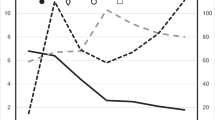Abstract
Most cases of diarrhea-associated hemolytic uremic syndrome (D+HUS) are caused by Shiga toxin-producing bacteria. Shiga toxin-producing Escherichia coli (STEC) O157:H7 has the strongest association worldwide with HUS. A massive outbreak of E. coli O157:H7 infections in Sakai, Osaka, Japan, in 1996 raised public and medical awareness of STEC. However, most cases are sporadic or occur in small clusters. Indeed, more than 100 sporadic or small cluster cases of D+HUS occur every year in Japan. The use of antibiotics in patients with definite or possible enteric STEC infections is controversial; however, there has been no randomized controlled trial to date showing the effectiveness of antibiotics for the prevention of the development of HUS. Thus, most investigators in western countries believe that antibiotics should not be administered to patients with such infections, and the management of HUS remains supportive. There are no specific therapies to ameliorate the course of the disease, and vascular injury leading to HUS is likely to be well under way by the time infected patients seek medical attention for diarrhea. The best way to prevent HUS is to prevent primary infection by Shiga toxin-producing bacteria.

Similar content being viewed by others
References
Karmali MA, Steele BT, Petric M, Lim C. Sporadic cases of haemolytic-uraemic syndrome associated with faecal cytotoxin and cytotoxin-producing Escherichia coli in stools. Lancet. 1983;1:619–20.
Yoshioka K, Yagi K, Moriguchi N. Clinical features and treatment of children with hemolytic uremic syndrome caused by enterohemorrhagic Escherichia coli O157:H7 infection: experience of an outbreak in Sakai City, 1996. Pediatr Int. 1999;41:223–7.
Fukushima H, Hashizume T, Morita Y, Tanaka J, Azuma K, Mizumoto Y, Kaneno M, Matsuura M, Konma K, Kitani T. Clinical experiences in Sakai City Hospital during the massive outbreak of enterohemorrhagic Escherichia coli O157 infections in Sakai City, 1996. Pediatr Int. 1999;41:213–7.
Bitzan M, Bickford BB, Foster GH. Verotoxin (Shiga toxin) sensitizes renal epithelial cells to increased heme toxicity: possible implications for the hemolytic uremic syndrome. J Am Soc Nephrol. 2004;15:2334–43.
Kamioka I, Yoshiya K, Satomura K, Kaito H, Fujita T, Iijima K, Nakanishi K, Yoshikawa N, Nozu K, Matsuo M. Risk factors for developing severe clinical course in HUS patients: a national survey in Japan. Pediatr Int. 2007 (in press).
Mead PS, Griffin PM. Escherichia coli O157:H7. Lancet 1998;352:1207–12.
Bell BP, Griffin PM, Lozano P, Christie DL, Kobayashi JM, Tarr PI. Predictors of hemolytic uremic syndrome in children during a large outbreak of Escherichia coli O157:H7 infections. Pediatrics. 1997;100:E12.
Wong CS, Jelacic S, Habeeb RL, Watkins SL, Tarr PI. The risk of the hemolytic-uremic syndrome after antibiotic treatment of Escherichia coli O157:H7 infections. N Engl J Med. 2000;342:1930–6.
Dundas S, Todd WT, Stewart AI, Murdoch PS, Chaudhuri AK, Hutchinson SJ. The central Scotland Escherichia coli O157:H7 outbreak: risk factors for the hemolytic uremic syndrome and death among hospitalized patients. Clin Infect Dis. 2001;33:923–31.
Grif K, Dierich MP, Karch H, Allerberger F. Strain-specific differences in the amount of Shiga toxin released from enterohemorrhagic Escherichia coli O157 following exposure to subinhibitory concentrations of antimicrobial agents. Eur J Clin Microbiol Infect Dis. 1998;17:761–6.
Kimmitt PT, Harwood CR, Barer MR. Toxin gene expression by Shiga toxin-producing Escherichia coli: the role of antibiotics and the bacterial SOS response. Emerg Infect Dis. 2000;6:458–65.
Safdar N, Said A, Gangnon RE, Maki DG. Risk of hemolytic uremic syndrome after antibiotic treatment of Escherichia coli O157:H7 enteritis: a meta-analysis. JAMA. 2002;288:996–1001.
Ikeda K, Ida O, Kimoto K, Takatorige T, Nakanishi N, Tatara K. Effect of early fosfomycin treatment on prevention of hemolytic uremic syndrome accompanying Escherichia coli O157:H7 infection. Clin Nephrol. 1999;52:357–62.
Wong CS, Brandt JR. Risk of hemolytic uremic syndrome from antibiotic treatment of Escherichia coli O157:H7 colitis. JAMA. 2002;288:3111.
Tarr PI, Gordon CA, Chandler WL. Shiga-toxin-producing Escherichia coli and haemolytic uraemic syndrome. Lancet. 2005;365:1073–86.
Ake JA, Jelacic S, Ciol MA, et al. Relative nephroprotection during Escherichia coli O157:H7 infections: association with intravenous volume expansion. Pediatrics. 2005;115:e673–80.
Tarr PI, Neill MA. Escherichia coli O157:H7. Gastroenterol Clin North Am. 2001;30:735–51.
Trachtman H, Cnaan A, Christen E, et al. Effect of an oral Shiga toxin-binding agent on diarrhea-associated hemolytic uremic syndrome in children: a randomized controlled trial. JAMA. 2003;291:1337–44.
Perez N, Spizzirri F, Rahman R, Suarez A, Larrubia C, Lasarte P. Steroids in the hemolytic uremic syndrome. Pediatr Nephrol. 1998;12:101–4.
Diekmann L. Treatment of the hemolytic-uremic syndrome with streptokinase and heparin (author’s transl). Klin Padiatr. 1980;192:430–5.
O’Regan S, Chesney RW, Mongeau JG, Robitaille P. Aspirin and dipyridamole therapy in the hemolytic-uremic syndrome. J Pediatr. 1980;97:473–6.
Gianviti A, Perna A, Caringella A, et al. Plasma exchange in children with hemolytic-uremic syndrome at risk of poor outcome. Am J Kidney Dis. 1993;22:264–6.
Loirat C, Sonsino E, Hinglais N, Jais JP, Landais P, Fermanian J. Treatment of the childhood haemolytic uraemic syndrome with plasma: a multicentre randomized controlled trial. Pediatr Nephrol. 1988;2:279–85.
Rizzoni G, Claris-Appiani A, Edefonti A, et al. Plasma infusion for hemolytic-uremic syndrome in children: results of a multicenter controlled trial. J Pediatr. 1988;112:284–90.
Ogborn MR, Crocker JF, Barnard DR. Plasma therapy for severe hemolytic-uremic syndrome in children in Atlantic Canada. CMAJ. 1990;143:1323–6.
Hughes DA, Beattie TJ, Murphy AV. Haemolytic uraemic syndrome: 17 years experience in a Scottish paediatric renal unit. Scott Med J. 1991;36:9–12.
Taylor CM, White RH, Winterborn MH, Rowe B. Haemolytic-uraemic syndrome: clinical experience of an outbreak in the West Midlands. Br Med J (Clin Res Ed). 1986;292:1513–6.
Bale JF Jr, Brasher C, Siegler RL. CNS manifestations of the hemolytic-uremic syndrome: relationship to metabolic alterations and prognosis. Am J Dis Child. 1980;134:869–72.
Brandt JR, Fouser LS, Watkins SL, et al. Escherichia coli O157:H7-associated hemolytic-uremic syndrome after ingestion of contaminated hamburgers. J Pediatr. 1994;125:519–26.
Author information
Authors and Affiliations
Corresponding author
About this article
Cite this article
Iijima, K., Kamioka, I. & Nozu, K. Management of diarrhea-associated hemolytic uremic syndrome in children. Clin Exp Nephrol 12, 16–19 (2008). https://doi.org/10.1007/s10157-007-0007-4
Received:
Accepted:
Published:
Issue Date:
DOI: https://doi.org/10.1007/s10157-007-0007-4




